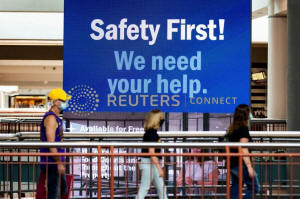U.S. retail sales slow in July; obstacles mount for
nascent economic recovery
 Send a link to a friend
Send a link to a friend
 [August 15, 2020] By
Lucia Mutikani [August 15, 2020] By
Lucia Mutikani
WASHINGTON (Reuters) - U.S. retail sales
increased less than expected in July as consumers cut back on purchases
of motor vehicles, and could slow further in the months ahead amid
spiraling new COVID-19 infections and a reduction in unemployment
benefit checks.
Despite the moderation in retail sales reported by the Commerce
Department on Friday, sales have recouped losses suffered when
businesses were shuttered to slow the spread of the coronavirus. The
third straight monthly gain lifted retail sales to their highest level
since the government started tracking the series in 1992. It supported
the view that consumer spending would rebound this quarter after a
record collapse in the second quarter.
Economists attributed the increase in retail sales over the past three
months to a $600 weekly unemployment benefits supplement from the
government, which amounted to almost $75 billion in July. The supplement
ended on July 31, leaving economists to expect a decline in retail sales
in August.

"It looks like the skies are darkening once again as the second-wave
shutdowns clamp down harder on economic activity and the federal
government stops sending $600 weekly checks to the unemployed," said
Chris Rupkey, chief economist at MUFG in New York. "The pandemic isn't
over yet and the recession won't be either if Congress and the president
can't come to an agreement on how to best support the nascent recovery
in a hurry."
Retail sales rose 1.2% last month after advancing 8.4% in June.
Economists polled by Reuters had forecast sales would rise 1.9% in July.
Sales increased 2.7% from a year ago in July.
President Donald Trump on Saturday signed a number of executive orders,
including one that extended the supplement, though he reduced the weekly
payout to $400.
States are required to cover $100 of the benefits under the order, but
they are under immense financial pressure due to the pandemic. The
remaining $300 will be funded from a limited emergency disaster relief
program, which economists estimated could be depleted as early as
September.
A top White House advisor said this week that Trump's plan would provide
an extra $300 per week. Republicans and Democrats are bickering over new
aid for the economy even as signs mount that activity is stalling as
coronavirus infections continue to spread across the United States.

Job growth slowed in July. About 28.3 million people are on unemployment
benefits.
The slowdown in retail sales in July was led by a 1.2% decline in
receipts at auto dealerships. That followed a 6.1% acceleration in June.
Consumers also cut back spending at hobby, musical instrument and book
stores as well as at building materials outlets.
[to top of second column] |

People visit the Destiny USA mall during the reopening, as the
coronavirus disease (COVID-19) restrictions are eased, in Syracuse,
New York, U.S., July 10, 2020. REUTERS/Maranie Staab

STEADY SENTIMENT
Purchases at electronics and appliance stores soared 22.9% last month, likely
reflecting strong demand as many Americans work from home.
Receipts at restaurants and bars increased 5.0%, though the pace slowed from the
26.7% notched in June. Online and mail-order retail sales rebounded 0.7%.
Furniture store sales were flat. Receipts at clothing stores increased 5.7%.
Excluding automobiles, gasoline, building materials and food services, retail
sales increased 1.4% in July after soaring 6.0% in June. These so-called core
retail sales correspond most closely with the consumer spending component of the
gross domestic product report.
Consumer spending collapsed at a 34.6% annualized pace in the second quarter.
That led GDP to plunge at a 32.9% rate last quarter, the deepest decline in
output since the government started keeping records in 1947.
A separate report from the University of Michigan on Friday showed consumer
sentiment steady in mid-August, though consumers anticipated "bad economic times
to persist not only in the year ahead" and many "expect no return to a period of
uninterrupted growth over the next five years."
Stocks on Wall Street were mixed in midday trading. The dollar <.DXY> was
trading lower against a basket of currencies while prices of U.S. Treasuries
rose.

"Providing further assistance to struggling households will be essential to
keeping growth momentum from faltering," said Lydia Boussour, a senior U.S.
economist at Oxford Economics in New York. "This is even more critical as recent
research have highlighted that low-income families have played a central role in
driving the initial phase of the recovery in consumption."
Though motor vehicle sales fell last month, manufacturers continued to ramp up
production, boosting output at the nation's factories, a third report from the
Federal Reserve showed. Manufacturing production rose 3.4% in July after surging
7.4% in June. Still, the third straight monthly gain left factory output about
8% below its level in February.
"Excess capacity throughout the economy will weigh on production of investment
goods," said Gus Faucher, chief economist at PNC Financial in Pittsburg. "The
biggest downside risk is a failure of Congress and the Trump administration to
agree on a fiscal stimulus package that would support consumer demand during a
period of very high unemployment."
(Reporting by Lucia Mutikani; Editing by Chizu Nomiyama and Paul Simao)
[© 2020 Thomson Reuters. All rights
reserved.] Copyright 2020 Reuters. All rights reserved. This material may not be published,
broadcast, rewritten or redistributed.
Thompson Reuters is solely responsible for this content. |